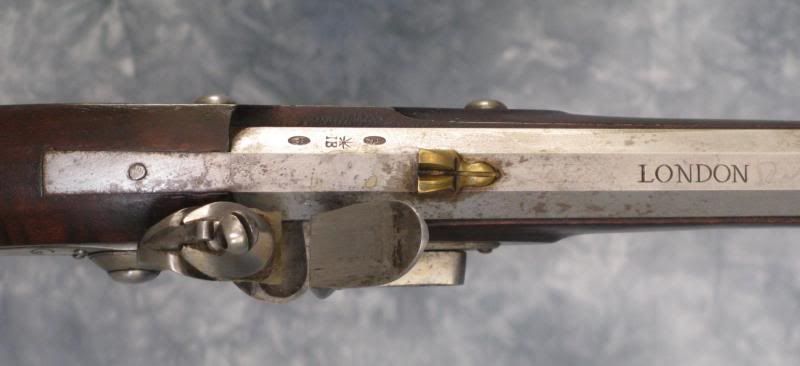plmeek
40 Cal.
After reading the thread by lethemgo, who was thinking about a .62 cal fowler and wanted to know more about the learning curve, I thought I would share my recent experiences.
I've been shooting percussion muzzleloaders on and off since the 1970's, but hadn't ventured into the realm of flintlocks until recently.
A couple months ago, I came across a second hand Jack Brooks Type G or Carolina trade gun that seemed like too good a deal to pass up. The gun is just a dream to handle and shoulder. It weighs only 6 lbs and with its 46" Getz barrel, it's 61" long overall. So long and lean like the line in the Bob Wills song, "But a long tall gall makes a bullfrog ball a jack." I had to take her out and give her a try.


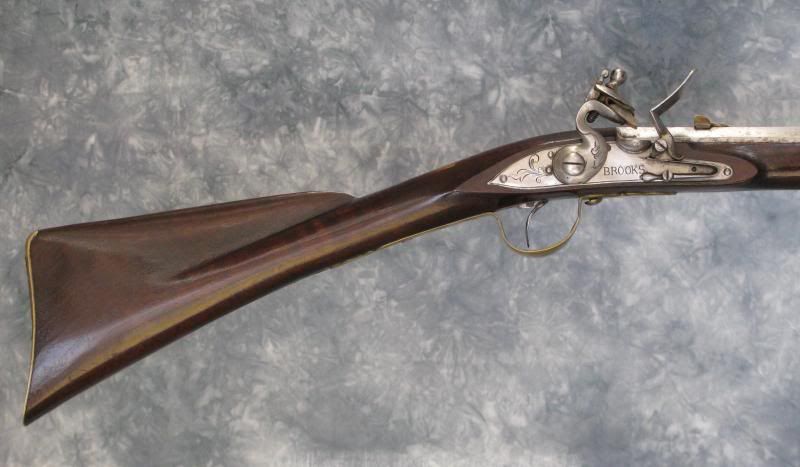
My first outing a couple weeks ago didn't go so well. Multiple flash-in-the-pans, hang fires, and no sparks had me pretty frustrated. The best I can say of that first session is, when she did go off, I was able to keep the shots on the paper at 50 yds. When the flint quit sparking, I flipped it over and got a few more shots before it got too dull to spark any more. I gave up and went home with my own version of St. Louis Blues.
After cleaning the gun, I started studying the lock and looking at the geometry of the lock, flint, and frizzen. The gun had a used flint in it when I bought it, so I had ordered some more flints of the same size from TOTW. I suspected that the flints were too small for the lock and made a practice flint from a small piece of wood to see where it should be striking the frizzen. I confirmed my suspicions. It was obvious that I needed a longer flint or move the ones I had further forward to get them to strike where they should.
Today, was forecast to be a perfect day for shooting with temps in the mid-70s. I picked out the best shaped flint of the dozen I had ordered and cut a new leather wrap without the slot in the rear for the screw. I positioned the flint in the jaws forward to mimic the position of the wood practice flint. And off to the range.
It took me a while to get set up on the bench, and I only got two shots off before a cease fire was called to change targets. These shots were high but encouraging (see target below). The sights are true to the originals, but a challenge to aim with. I changed to a six o'clock hold for the next five shots. As you can see, I was jerking the trigger instead of squeezing it and pulling the shots to the left. But at least the flint was sparking and sometimes the ignition was almost instantaneous.
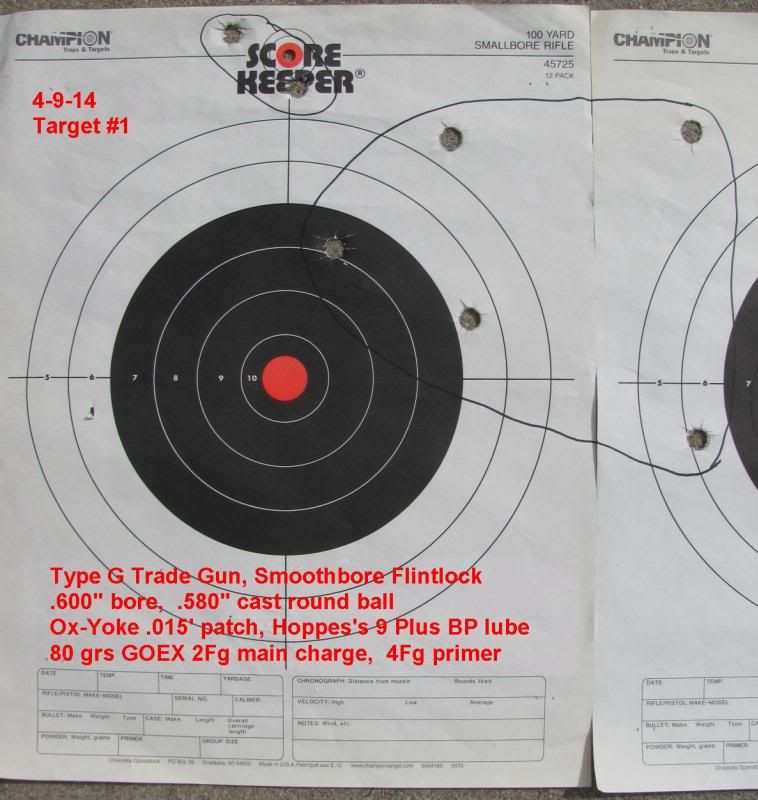
On the next five shots, I concentrated more on the sight picture and trigger squeeze and got some encouraging results. I also picked the vent hole and cleaned the pan and flint between each shot. A friend calls flintlocks "tinker toys" because you have to tinker and toy with them all the time to keep 'em shooting. This time I got 4 in the black and only one flier. The two holes with the blue "X's" are from the previous 5 shot group as Target 1 & 2 were side by side.
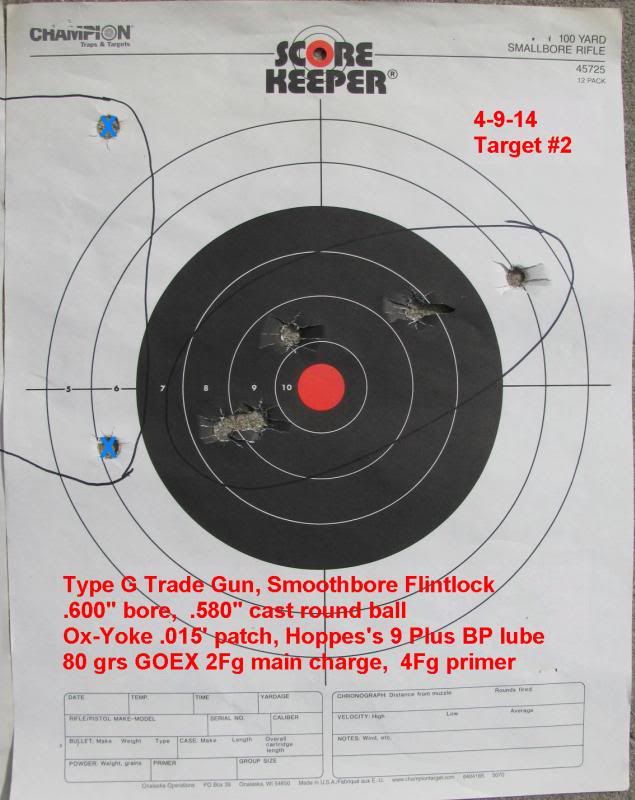
The flint was still sparking, so I hung two more targets.
Target three results are shown below. More problems with the sight picture and not concentrating enough on the trigger squeeze and follow through.
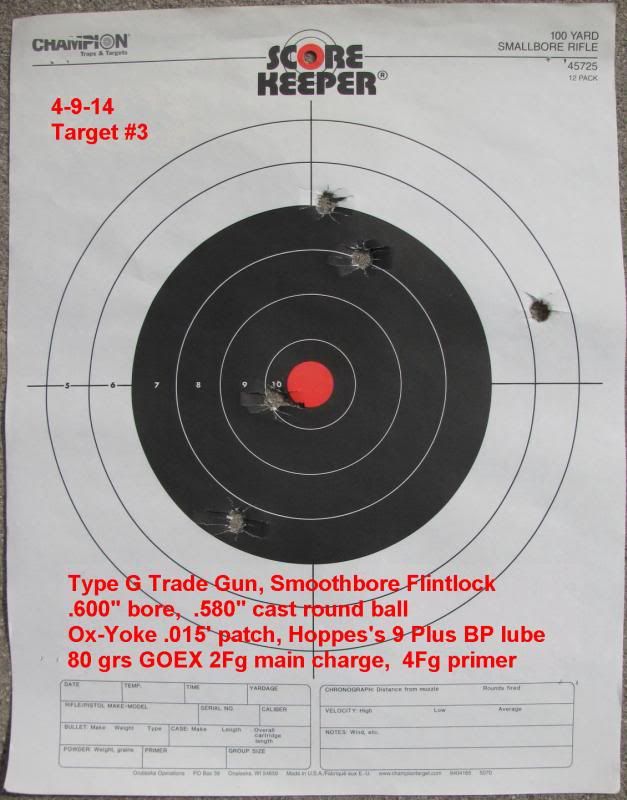
All the shooting so far was with .580" cast round balls and .015" patches. I switched to some .588" cast balls and .010" patches.
Jack Brooks slightly funnels the muzzles so one can start the patched ball with thumb pressure. I used a short starter after that so I can get a good grip on the range rod for the long barrel. Both ball and patch combinations required some force to ram home, but I didn't have to swab the barrel during the whole shooting session.
Here are the results with the slightly larger balls. Yes, I cheated a little on this one. After I saw this 4 shot group, I quit before I messed it up.
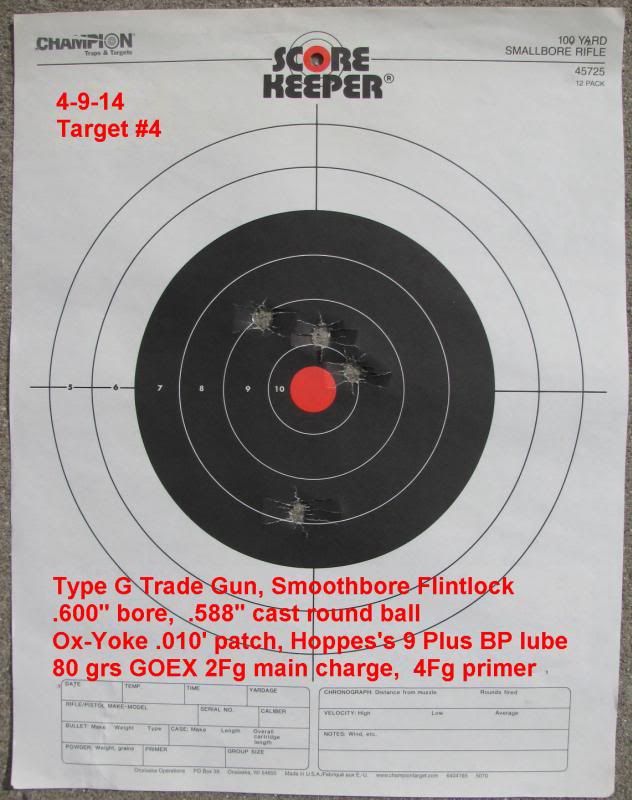
I got over 20 shots on the same flint, and it still looks pretty good. I learned getting the right flint in the right position keeps it from smashing into the frizzen, and allows it to scrape the sparks from the face instead of chipping them out.
I had three flash-in-the-pans, which I didn't think was too bad for my second session with the flintlock. I just have to continue tinkering and toying to keep things clean and open.
By the way, all shooting was done at 50 yds and from the bench.
Now I feel like I've moved up the learning curve and inch or two.
Phil
I've been shooting percussion muzzleloaders on and off since the 1970's, but hadn't ventured into the realm of flintlocks until recently.
A couple months ago, I came across a second hand Jack Brooks Type G or Carolina trade gun that seemed like too good a deal to pass up. The gun is just a dream to handle and shoulder. It weighs only 6 lbs and with its 46" Getz barrel, it's 61" long overall. So long and lean like the line in the Bob Wills song, "But a long tall gall makes a bullfrog ball a jack." I had to take her out and give her a try.



My first outing a couple weeks ago didn't go so well. Multiple flash-in-the-pans, hang fires, and no sparks had me pretty frustrated. The best I can say of that first session is, when she did go off, I was able to keep the shots on the paper at 50 yds. When the flint quit sparking, I flipped it over and got a few more shots before it got too dull to spark any more. I gave up and went home with my own version of St. Louis Blues.
After cleaning the gun, I started studying the lock and looking at the geometry of the lock, flint, and frizzen. The gun had a used flint in it when I bought it, so I had ordered some more flints of the same size from TOTW. I suspected that the flints were too small for the lock and made a practice flint from a small piece of wood to see where it should be striking the frizzen. I confirmed my suspicions. It was obvious that I needed a longer flint or move the ones I had further forward to get them to strike where they should.
Today, was forecast to be a perfect day for shooting with temps in the mid-70s. I picked out the best shaped flint of the dozen I had ordered and cut a new leather wrap without the slot in the rear for the screw. I positioned the flint in the jaws forward to mimic the position of the wood practice flint. And off to the range.
It took me a while to get set up on the bench, and I only got two shots off before a cease fire was called to change targets. These shots were high but encouraging (see target below). The sights are true to the originals, but a challenge to aim with. I changed to a six o'clock hold for the next five shots. As you can see, I was jerking the trigger instead of squeezing it and pulling the shots to the left. But at least the flint was sparking and sometimes the ignition was almost instantaneous.

On the next five shots, I concentrated more on the sight picture and trigger squeeze and got some encouraging results. I also picked the vent hole and cleaned the pan and flint between each shot. A friend calls flintlocks "tinker toys" because you have to tinker and toy with them all the time to keep 'em shooting. This time I got 4 in the black and only one flier. The two holes with the blue "X's" are from the previous 5 shot group as Target 1 & 2 were side by side.

The flint was still sparking, so I hung two more targets.
Target three results are shown below. More problems with the sight picture and not concentrating enough on the trigger squeeze and follow through.

All the shooting so far was with .580" cast round balls and .015" patches. I switched to some .588" cast balls and .010" patches.
Jack Brooks slightly funnels the muzzles so one can start the patched ball with thumb pressure. I used a short starter after that so I can get a good grip on the range rod for the long barrel. Both ball and patch combinations required some force to ram home, but I didn't have to swab the barrel during the whole shooting session.
Here are the results with the slightly larger balls. Yes, I cheated a little on this one. After I saw this 4 shot group, I quit before I messed it up.

I got over 20 shots on the same flint, and it still looks pretty good. I learned getting the right flint in the right position keeps it from smashing into the frizzen, and allows it to scrape the sparks from the face instead of chipping them out.
I had three flash-in-the-pans, which I didn't think was too bad for my second session with the flintlock. I just have to continue tinkering and toying to keep things clean and open.
By the way, all shooting was done at 50 yds and from the bench.
Now I feel like I've moved up the learning curve and inch or two.
Phil




 You might try less powder.
You might try less powder.